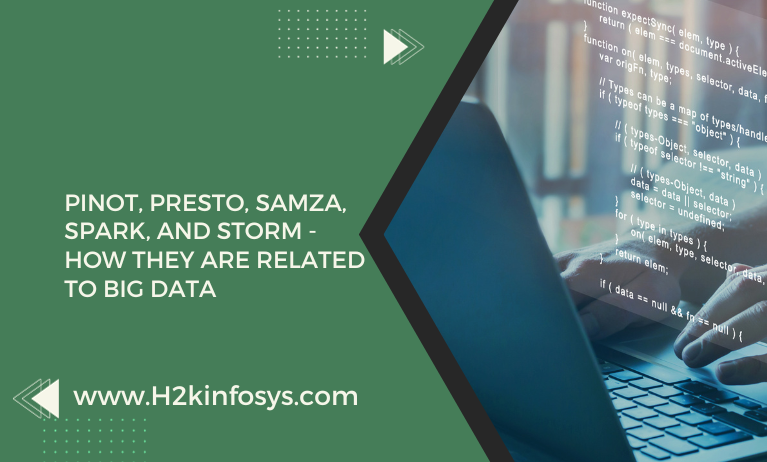Let’s check out how these 5 tools are related to Big Data. Check out the Big Data course online to learn more about these tools.
1.Pinot
Pinot is a real-time distributed OLAP data storage designed to enable analytics users to do low-latency queries. Horizontal scaling is able to provide that low latency even with big data sets and high throughput because of its design. Pinot stores data in a columnar format and employs a number of indexing algorithms to filter, aggregate, and organise data in order to deliver the claimed performance. Furthermore, dynamic configuration changes are possible without compromising query performance or data accessibility.
According to Apache, Pinot can execute thousands of queries per second, millions of data events, and trillions of documents altogether. The system operates with mutable data but has a fault-tolerant architecture with no single point of failure and assumes that all stored data is immutable. Pinot, a 2013-started internal project at LinkedIn, was made available to the public in 2015 and upgraded to an Apache top-level project in 2021.
Big Data Pinot also has the following characteristics:
- A SQL interface for interactive querying and a REST API for programming queries;
- near-real-time data ingestion from streaming sources;
- batch ingestion from HDFS, Spark, and cloud storage services;
- support for running machine learning algorithms against stored datasets for anomaly detection.
2.Presto
This open-source SQL query engine, formerly known as PrestoDB, is capable of handling both quick queries and enormous amounts of data in distributed data sets. Big Data Presto scales to enable analytics applications spanning numerous petabytes of data in data warehouses and other repositories and is built for low-latency interactive querying.
In 2012, Facebook began creating Presto. The technology separated into two branches after its founders departed the company in 2018: PrestoSQL, which the original engineers founded, and PrestoDB, which was still led by Facebook. Until December 2020, when PrestoSQL became Trino and PrestoDB returned to its original moniker of Presto, that is. The Presto Foundation, which was established as a member of the Linux Foundation in 2010, now oversees the Presto open-source project.
Additionally, Presto has the following attributes:
- Support for combining data from several sources into a single query,
query response times that often range from a few milliseconds to minutes,
- and support for querying data in Hive, other databases, and bespoke data stores.
3.Samza
Samza is a distributed stream processing technology created by LinkedIn that is currently an Apache-led open-source project. Samza, according to the project website, enables users to create stateful apps that can process data from sources like HDFS and Kafka in real-time.
The system offers a standalone deployment option in addition to running on top of Big Data Hadoop YARN or Kubernetes. According to the Samza website, it can process “several terabytes” of state data quickly and efficiently with low latency and great throughput. It can also leverage the same code created for data streaming jobs to run batch apps via a uniform API. These additional characteristics are listed below:
- built-in Hadoop, Kafka, and other data platform integration;
ability to function as an embedded library in Java and Scala applications;
- and fault-tolerant capabilities intended to facilitate quick system failure recovery.
4.Spark
An in-memory data processing and analytics engine called Apache Spark can operate independently or in clusters controlled by big data Hadoop YARN, Mesos, and Kubernetes. For batch and streaming applications, machine learning, and graph processing use cases, it provides large-scale data conversions and analysis. The following collection of built-in modules and libraries supports all of this:
- Spark Streaming and Structured Streaming are two stream processing modules.
- MLlib is a machine learning library with methods and associated tools.
- GraphX is an API that adds support for graph applications.
- Spark SQL is for optimal processing of structured data using SQL queries.
Data can be accessible from a number of sources, including flat-file data sets, relational and NoSQL databases, and HDFS. Additionally, Spark offers a variety of APIs for developers and supports a number of file formats.
However, speed is Spark’s strongest selling point, with developers claiming that when processing batch operations in memory, Spark can process data up to 100 times quicker than established rival MapReduce. As a result, Spark, which also serves as a general-purpose engine, has emerged as the top option for many batch applications in big data contexts. It was originally created at the University of California, Berkeley, and is now maintained by Apache. When data sets are too big to fit into the available memory, they can also be processed on disk.
5.Storm
Storm is a distributed real-time processing system created by Big Data Apache that is intended to successfully process unlimited streams of data. It can be used for applications such as real-time analytics, online machine learning, continuous computation, and extracting, converting, and loading tasks, according to the project website.
Similar to Hadoop clusters, Storm clusters allow applications to operate continuously unless they are terminated. The system ensures that data will be processed and is fault-tolerant. Additionally, according to the Apache Storm website, it may be utilised with any database and messaging system. The following components are also present in Storm:
- Storm SQL, a feature that allows SQL queries to be executed against streaming data sets,
- Trident and Stream API,
- two further higher-level Storm processing interfaces,
- and the cluster coordination system Apache ZooKeeper are all examples of these features.
Conclusion To learn more about these tools, check out the Big Data online course.































One Response